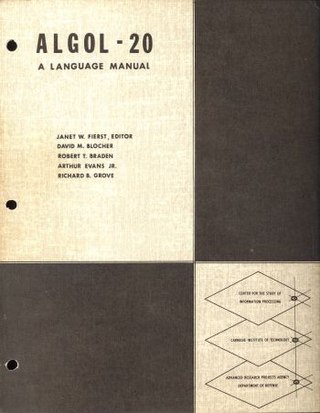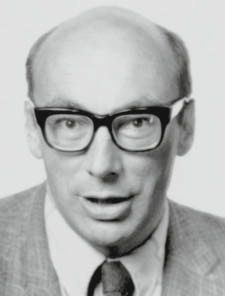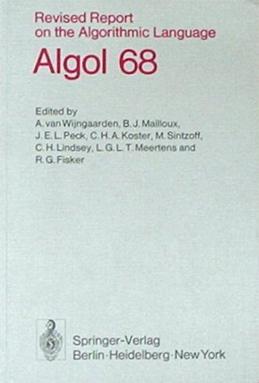Related Research Articles

ALGOL is a family of imperative computer programming languages originally developed in 1958. ALGOL heavily influenced many other languages and was the standard method for algorithm description used by the Association for Computing Machinery (ACM) in textbooks and academic sources for more than thirty years.
In computing, a compiler is a computer program that translates computer code written in one programming language into another language. The name "compiler" is primarily used for programs that translate source code from a high-level programming language to a low-level programming language to create an executable program.
Dartmouth BASIC is the original version of the BASIC programming language. It was designed by two professors at Dartmouth College, John G. Kemeny and Thomas E. Kurtz. With the underlying Dartmouth Time Sharing System (DTSS), it offered an interactive programming environment to all undergraduates as well as the larger university community.
Thomas Eugene Kurtz is a retired Dartmouth professor of mathematics and computer scientist, who along with his colleague John G. Kemeny set in motion the then revolutionary concept of making computers as freely available to college students as library books were, by implementing the concept of time-sharing at Dartmouth College. In his mission to allow non-expert users to interact with the computer, he co-developed the BASIC programming language and the Dartmouth Time Sharing System during 1963 to 1964.
In computer programming, a thunk is a subroutine used to inject a calculation into another subroutine. Thunks are primarily used to delay a calculation until its result is needed, or to insert operations at the beginning or end of the other subroutine. They have many other applications in compiler code generation and modular programming.
The Dartmouth Time-Sharing System (DTSS) is a discontinued operating system first developed at Dartmouth College between 1963 and 1964. It was the first successful large-scale time-sharing system to be implemented, and was also the system for which the BASIC language was developed. DTSS was developed continually over the next decade, reimplemented on several generations of computers, and finally shut down in 1999.

Peter John Landin was a British computer scientist. He was one of the first to realise that the lambda calculus could be used to model a programming language, an insight that is essential to the development of both functional programming and denotational semantics.
ALGOL 60 is a member of the ALGOL family of computer programming languages. It followed on from ALGOL 58 which had introduced code blocks and the begin and end pairs for delimiting them, representing a key advance in the rise of structured programming. ALGOL 60 was one of the first languages implementing function definitions. ALGOL 60 function definitions could be nested within one another, with lexical scope. It gave rise to many other languages, including CPL, PL/I, Simula, BCPL, B, Pascal, and C. Practically every computer of the era had a systems programming language based on ALGOL 60 concepts.

ALGOL 68 is an imperative programming language that was conceived as a successor to the ALGOL 60 programming language, designed with the goal of a much wider scope of application and more rigorously defined syntax and semantics.
ALGOL 58, originally named IAL, is one of the family of ALGOL computer programming languages. It was an early compromise design soon superseded by ALGOL 60. According to John Backus
The Zurich ACM-GAMM Conference had two principal motives in proposing the IAL: (a) To provide a means of communicating numerical methods and other procedures between people, and (b) To provide a means of realizing a stated process on a variety of machines...
The Navy Electronics Laboratory International ALGOL Compiler (NELIAC) is a dialect and compiler implementation of the programming language ALGOL 58, developed by the Navy Electronics Laboratory (NEL) in 1958.

The LGP-30, standing for Librascope General Purpose and then Librascope General Precision, is an early off-the-shelf computer. It was manufactured by the Librascope company of Glendale, California, and sold and serviced by the Royal Precision Electronic Computer Company, a joint venture with the Royal McBee division of the Royal Typewriter Company. The LGP-30 was first manufactured in 1956, at a retail price of $47,000, equivalent to $510,000 in 2022.
Jensen's device is a computer programming technique that exploits call by name. It was devised by Danish computer scientist Jørn Jensen, who worked with Peter Naur at Regnecentralen. They worked on the GIER ALGOL compiler, one of the earliest correct implementations of ALGOL 60. ALGOL 60 used call by name. During his Turing Award speech, Naur mentions his work with Jensen on GIER ALGOL.
Klaus Samelson was a German mathematician, physicist, and computer pioneer in the area of programming language translation and push-pop stack algorithms for sequential formula translation on computers.

In computing, a compiler is a computer program that transforms source code written in a programming language or computer language, into another computer language. The most common reason for transforming source code is to create an executable program.
The history of the programming language Scheme begins with the development of earlier members of the Lisp family of languages during the second half of the twentieth century. During the design and development period of Scheme, language designers Guy L. Steele and Gerald Jay Sussman released an influential series of Massachusetts Institute of Technology (MIT) AI Memos known as the Lambda Papers (1975–1980). This resulted in the growth of popularity in the language and the era of standardization from 1990 onward. Much of the history of Scheme has been documented by the developers themselves.
IFIP Working Group 2.1 on Algorithmic Languages and Calculi is a working group of the International Federation for Information Processing (IFIP).
DOPE, short for Dartmouth Oversimplified Programming Experiment, was a simple programming language designed by John Kemény in 1962 to offer students a transition from flow-charting to programming the LGP-30. Lessons learned from implementing DOPE were subsequently applied to the invention and development of BASIC.
References
- ↑ P. Z. Ingerman, "Thunks: a way of compiling procedure statements with some comments on procedure declarations", Communications of the ACM 4:1, January 1961, pages 55–58.
- ↑ E. T. Irons and W. Feurzeig, "Comments on the implementation of recursive procedures and blocks in Algol-60", Communications of the ACM 4:11, January 1961, pages 65–69
- ↑ Thomas E. Kurtz, "Basic", History of Programming Languages, Association for Computing Machinery, June 1978, page 516.
- ↑ K. Samelson and F. L. Bauer, "Sequential formula translation", Communications of the ACM 3:2, February 1960, pages 76–83.
- ↑ (David Gries, "The use of transition matrices in compiling", Communications of the ACM 11:1, January 1968, pages 26–34.
- ↑ ALGOL for the LGP-30, A Comparison, Computation Center, Dartmouth College February 16, 1962.
- ↑ Kurtz, loc. cit.
- ↑ Kurtz, op. cit., page 517.
- ↑ A Manual for SCALP, being a Self Contained Algol Processor for the General Precision LGP-30, CCM-7A, Computation Center, Dartmouth College, January 1, 1964.
- ↑ Sidney Marshall, Preliminary Report on an ALGOL 68 Implementation, Kiewit Computation Center, Dartmouth College, December 1, 1969.